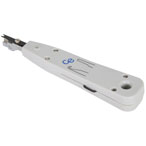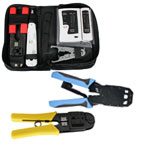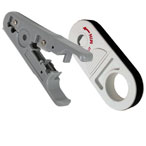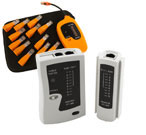

The network tech's vision into cabling bandwidth
CableIQ qualification tester is the first cabling bandwidth tester for network technicians. This network cable tester It gives even the most novice tech the vision to see what speeds existing cabling can support, quickly isolate cabling from network problems, and discover what is at the far end of any cable. That means network techs can close trouble tickets faster, reduce on-call time, and save money by better utilizing their existing infrastructure.
Qualifies - Tests if your existing cabling has the bandwidth to support voice, 10/100, VoIP or Gigabit Ethernet
Troubleshoots - shows why existing network cabling cannot support the network's bandwidth requirement (e.g. crosstalk at 11 metres)
Discovers - detects what's at the end of any cable and displays device configuration (speed/duplex/pairing)
Identifies unused switch ports that can be reallocated
Graphically maps wiring configuration and shows distance to faults with Intelligent Wiremap
Tests all copper cabling media: twisted-pair, coax, and audio cabling
CableIQ version 1.80 has been released and is now available for download
This requires both the CableIQ Reporter Software 2.0 and the CableIQ Firmware 1.80 to complete the update. The details on how to perform the update and the files can be found here on Fluke Networks Website.
Reduce escalated problems by as much as 30%
CableIQ qualification tester's powerful troubleshooting capability and intuitive interface enable your frontline technicians to identify and troubleshoot a wider range of problems within your infrastructure. Is the port active? Are the duplex settings matched? Is it a network problem or a cable problem? Can the cable support the required network bandwidth? CableIQ network cable tester is the only tool that can answer all these questions before trouble tickets are escalated to the next level reducing problem escalation by up to 30%.
To view a product demo of the CableIQ Qualification Tester, please Click Here
Bandwidth Qualification
When you deploy Voice over IP (VoIP) or Gigabit Ethernet, you want to make sure that the existing cabling will support the bandwidth requirements of your new equipment. Your cabling was certified, but moves adds and changes have rendered many links incapable of running desired speeds. CableIQ quickly reveals whether a link, including patch cords, is qualified for voice, 10/100BASE-T, VoIP, or Gig. Knowing your cabling's bandwidth capabilities before upgrading can prevent countless hours of future downtime and labor hours wasted on unnecessary troubleshooting.
See what speeds your existing cabling can support.
CableIQ's four-second Autotest clearly indicates with a check mark which speeds and applications the tested cable can run.
Cable Troubleshooting
Plug into any cable, patch panel, or wall jack and see both the cable details (length/wiremap) and far-end device details (speed/duplex settings) at once. A series of both cable and network test functions help you isolate connectivity problems. For instance, if Discover mode shows duplex settings are matched but the problem persists, run Autotest to see if the cabling can support the required bandwidth. If a link is not qualified, CableIQ provides detailed information on the nature and location of cabling performance faults such as crosstalk or large impedance changes. With CableIQ your techs can close trouble tickets faster by cutting cable troubleshooting time in half.
Troubleshoot cabling faults in half the time.
This screen shot represents a cabling link that did not qualify for 1000BASE-T because of a connection fault at 4.1 metres.
Infrastructure Discovery
Free up 10% or more of your switch ports
CableIQ's Discover mode shows you exactly what's at the far end of any cable. At the switch, test each cable one at a time. You can quickly see whether the cable is open at the far end, or is connected to a PC. Or use CableIQ's hub blink feature from the workstation to flash the corresponding switch port LED. You may be surprised at how many unused ports you can free up and redeploy using CableIQ.
Determine where installed cables are routed, all from one location.
Attach Remote ID's in different locations, then perform multiple cable tests from the distribution center or wiring closet. CableIQ provides the wiremap, pair lengths, distance to fault, and remote ID number of each tested cabling link.
Intelligent Wiremap
Intelligent wiremap tests for length, shorts, split pairs or opens and displays with an intuitive graphical interface where a fault is located.
CableIQ's Intelligent Wiremap shows pin 6 open at far end of tested cable (130 ft/34 metres).
IntelliTone Technology
Locate cables and wires with superior accuracy
CableIQ supports IntelliTone digital toning by:
Finding cables easier and tracing with better accuracy than any other tool on the market
Toning and tracing safely on a live network
Providing two digital tones and four analog tones
Featuring IntelliTone cable mapping; after tracing, use the IntelliTone Pro Probe 200 to verify wiremap
Easy-to-use
Empower frontline techs with an easy-to-use-tool
Intuitive user interface and graphical display guides user with little or no training required.
Rotary knob makes learning easy and operation simple you always know what test mode is selected
Portable, lightweight, rugged ergonomic design for easy field use
Four AA batteries - Long lasting battery life for several weeks of testing
Remote adapter doubles as a protective endcap.
Customer quote: "I handed CableIQ to our level III techs, they turned the unit on and began testing within two minutes of reviewing the various available selections." --Telecommunications Analyst
CableIQ Kit Choices
To maximize the value of your CableIQ ownership, choose one of our specialized kits. Each kit is tailored for qualification testing in specific work environments shown below in a convenient comparison chart.
What is Qualification?
Qualification is a new category of testers designed to meet the emerging needs of network technicians who need to upgrade to higher network speeds as well as troubleshoot connectivity problems. Qualification testers, like Fluke Networks new CableIQ Qualification Tester, determines if an existing cabling link can or can not support certain network speeds and technologies. This differs from certification testers, like the DTX CableAnalyzer, which guarantees cabling installations comply with TIA/ISO performance standards and basic verification testers, like the MicroScanner Pro, which tests if the cable is connected correctly.
Qualification testers allow network technicians to perform a series of troubleshooting steps to better isolate cabling from network problems. For example, a first step in troubleshooting a network connectivity problem might be to check the speed and duplex settings of connected devices. If the tester shows the settings are matched, but the problem persists, a qualification test can be performed. Performing a qualification test will allow the technician to identify whether insufficient cabling bandwidth is the cause of the problem. Knowing your cabling's bandwidth capability allows you to close trouble tickets faster and helps ensure seamless upgrades to higher network speeds.
Choosing the right tool for the job
When to use a qualification tester: If you are a network technician, and need to see whether the existing cabling will support your 1000BASE-T network, a qualification tool is the right choice. If you need to troubleshoot connectivity problems and isolate cabling problems from network problems, then qualification is the perfect solution. If you have an existing network and are doing small adds, moves, and changes, or are setting up a temporary network and just need to qualify it for a specific network technology, a qualification tool is a good option.
When to use a certification tester: If you're a commercial installer or network owner who needs to prove that all cabling has been installed correctly, and meets TIA or ISO link specifications, you must certify it. If you are in a troubleshooting environment, and need to show unequivocally that the link under test is failing category 5e or 6 performance requirements according to TIA or ISO standards, your only choice is a certification tool. If you have a mixture of fibre and copper cabling, and often need to test both, cable certification tools do that best.
To receive the support and financial security of a manufacturer's warranty, certification to TIA/ISO standards is your only option. Anything else makes the installer liable for the performance of the installation which can be quite costly. For example, a large 1000 link installation could represent a $100,000 (USD) project, which can be a hefty liability if manufacturer warranty is not obtained.
When to use a verification tool: Verification tools are typically used by any technician who pulls and terminates cable or performs basic moves, adds and changes. These tools are used as a first line of defense in finding connection and wire-pairing faults.



IntelliTone Pro 200 LAN Toner Includes: IntelliTone Pro 200 LAN Toner, coax F connector adapter, RJ11 and RJ 45 patch cables, test leads with alligator clips, lanyard, quick start guide, and 9 volt battery.
Get advanced vision for locating cables more effectively at patch panels, switches, termination blocks, or hidden within bundles. Our new IntelliTone Pro Toner and Probe Kits find the cables others can't.
The IntelliTone™ Pro LAN Toner and Probe Series from Fluke Networks is the first toner and probe to offer digital and analog signaling all in one tool. That means it’s equipped with the most powerful cable location technologies for any work environment. Use digital mode to trace and locate data cabling safely and effectively on active networks. Use analog mode to isolate individual wire pairs, and trace voice, audio, and video cabling.
The IntelliTone™ Pro LAN Toner and Probe Series from Fluke Networks gives you superior vision for locating cables hidden in floors, ceilings, walls, and in bundles. Its breakthrough digital technology makes it the first tool to tone and trace safely and effectively on active networks.
Digital vs Analog
Only IntelliTone™ Pro LAN Toners and Probes offer the powerful combination of digital and analog technologies to resolve common infrastructure problems that arise during installing, maintaining, and changing of your network.
Digital and analog toning in one tool.
Today’s media networks are more diverse than ever. Most buildings have a combination of telephone, twisted-pair data, coax, and security/alarm wiring. Verifying proper routing and termination of this diverse set of cabling types requires tools optimized for different frequencies, connector types, and work environments. Until now, no single tool has combined the right technologies to operate across all copper media types, and in all environments. IntelliTone Pro changes that by combining cutting-edge digital and analog signaling to locate and verify virtually any copper cable, regardless of application or environment.
When to use digital
IntelliTone Pro’s digital encoded signal should primarily be used on high-grade data cabling (Cat 5e/ Cat 6/Cat 6a), and in active network environments. It operates at a high-frequency to match the higher frequency data the cable plant is designed to carry. This allows the tone to overcome competing data signals and aggressive low-frequency terminations of Ethernet switches. That means LAN cabling technicians can quickly zero in on the right cable during installations or troubleshooting.
Digital toning is especially helpful once the cable has been located as it displays cable wiremap and checks for shorts, opens and miswires. The IntelliTone Pro 200 probe has an RJ45 input port and CableMap feature, allowing it to be plugged directly into a patch panel or wall port. The benefit of this wiremap test is two-fold. It eliminates the need for both a toner to a wiremapper, and provides 100% confirmation that the right cable has been located.
When to use analog
IntelliTone Pro’s SmartTone analog toning can be used on voice-grade cabling (Cat 3 and below), as well as coax, security/alarm, and speaker wiring. These cables are optimized for lower frequency transmissions, and therefore are more easily isolated with a low-frequency tone. It should also be used in areas with relatively low interference from electronic devices. In high-interference environments, digital may still be a better choice.
SmartTone analog toning eliminates frustrating guesswork locating individual wire pairs during installations. The SmartTone analog signal will change ‘songs’ each time the pair under test is shorted together. This provides telecom technicians a decisive way to identify individual wire pairs before punching them down on a jack or a block, or when diagnosing voice transmission problems.
Local and Isolate Cabling
Isolate Terminated Cables
The IntelliTone™ Pro LAN Toner uses the unique properties of twisted pair cabling to create a balanced signal that minimizes the effect of signal bleed. The smart digital signal processing in the IntelliTone™ Pro Probe clearly identifies this signal with audio and LED visual indicators, allowing you to rapidly isolate the correct cable from a bundle or on a patch panel. IntelliTone™ eliminates hours of cable confusion—and you can count on getting it right the first time.
Isolate Individual Wire Pairs
With traditional analog toners and probes, isolating individual wire pairs precisely can be almost impossible because of signal bleed between pairs. As a result, wire pairs are often routed and terminated incorrectly the first time. Redoing incorrect terminations or pulling new wiring wastes tremendous amounts of time and money. IntelliTone Pro’s SmartTone analog technology cuts out the guesswork and improves accuracy by providing definitive confirmation when the pair under test is located. Just short the pair under test, and the audible tone will change its cadence. The difference is dramatic.
Verify Cable Continuity
Eliminate callbacks during cabling moves, adds and changes with the powerful diagnostic capabilities of IntelliTone. The IntelliTone Pro 200 Probe features a CABLEMAP capability that identifies common cable miswires in twisted pair cabling. IntelliTone technology automates the testing of each conductor for end-to-end continuity; LED lights and tones clearly indicate miswires such as opens, shorts or reversed pairs.
Tone Live Networks
Modern network devices use aggressive termination schemes for cables connected to their ports. While this termination reduces noise and crosstalk in the cable, it can also absorb an analog toner signal, making the connected cable impossible to detect with an analog audio probe. The result is that locating an unlabeled network can take hours with analog technology. Unlike analog signals, the IntelliTone digital signal stays strong despite common mode termination. And the IntelliTone Pro Toner automates toning individual cable conductors, making it quick, efficient and safe to locate cables on active networks.
Identify Telecom Services
Identify and diagnose POTS with multi-line Telco detect, polarity and ring indication
Service - Is the RJ45 jack a datacom jack, a phone jack or a dead jack? IntelliTone Pro LAN 200 Toners take the guesswork out of hunting for an active jack, or a jack with the right service. LEDs clearly identify common services found on today's networks, including telecom and datacom services and 10/100/1Gb Ethernet links.
Telecom Troubleshooting - Check telecom services with Line 1 continuity and polarity testing on the IntelliTone Pro LAN 100 and 200 Toners. The IntelliTone Pro 200 Toner adds Line 2 troubleshooting. Confirm telecom circuits with the built-in talk battery capability.
Verify Ethernet Service
Perform moves, adds and changes with powerful diagnostic capabilities of the IntelliTone Pro 200 Toner & Probe
Toning - IntelliTone makes it easy to quickly locate the cable in the equipment closet when performing moves, adds and changes. Unconnected cable can be quickly isolated in the presence of bleed.
Cablemap - The IntelliTone Pro LAN 200 Probe features a CABLEMAP capability that identifies common cable miswires in twisted pair cabling. Complete per-pin verification of TIA568 wiring identifies the exact wire that is open, shorted or miswired. LED lights and distinctive tones clearly indicate miswires. The built-in Cablemap feature eliminates the need to carry separate tools or returning to the far-end to replace the toner with a mapper. The IntelliTone Pro LAN 200 Kit is the all-in-one tool to locate and map Category 5 cabling even when plugged into a switch, and verify link service after moves, adds and changes.
Verify Ethernet Service - Is the link pulse correct, reversed due to a swap cable of uplink port, or MDIX capable? Identify active Ethernet services present at the office wallplate. LED lights clearly indicate the presence of normal, reversed or MDIX Ethernet link connectivity.
Cable Toning Tips
IntelliTone Pro is a digital toning system optimized for toning into modern network equipment and Category 5 cabling. To achieve this, IntelliTone uses radio frequencies and a digital tone packet that drives all 4 pairs with a variety of toning methods.
Datacom network moves, adds and changes using IntelliTone Pro Toners and Probes
In recent years, installation of structured cable has been to uniform standards. The TIA-568A standard requires that all work areas be wired with a minimum of two jacks with the horizontal cabling being four-pair 100 ohm UTP. This typically consists of 2 or more Cat5e cable runs directly from a wall plate jack to a patch panel.
Plugging in
IntelliTone is a digital toning system featuring an 8-position modular jack. This allows the toner to be plugged in either at the wall jack with the included patch cable or, if the wall jack is obstructed but connected, the patch cable can be removed from the PC and plugged directly into the toner.
Wall jacks are often unmarked or misconnected. Adding to the confusion, the 8-position modular jack can be used for either data or telecom services.
Service ID provides the first clue
The IntelliTone Pro LAN 200 Toner features a service ID indicating the presence of service on the line. When plugged in to a wall jack, it provides the first indication of where to look for the cable in the closet. A 4-position jack is sure to be telecom service, whereas an 8-position jack could be telecom or data (network) connection. The presence of telecom service typically means looking for the signal on a 110 block with an active connection to the phone system.
The presence of Ethernet indicates the connection is active and best located on the patch cables from the patch panel to the switch. If the connection is open then it likely not patched or connected. If the open LED is extinguished, the toner is detecting a connection across the center pins of the jack. This could be an un-plugged network device or unrecognized service.
Locating in the closet
The tone can be located on un-patched connections by moving the probe from jack to jack on the patch panel. It is typical to get a reading of 4-6 in locate mode with the black probe tip inserted into the jack. Neighboring jacks and cable will exhibit lower signal levels as indicated by the LED display.
If the service identification in the office indicated an Ethernet connection, the user should begin probing the cables that are patched to active network equipment. It is typical to get a reading of 7-8 on the toned cable.
Once the cable is located, the IntelliTone Pro LAN 200 probe provides a Cablemap to assure correct pin-to-pin wiring. By removing the patch cable from the switch, or by plugging a patch cable into the patch panel jack, the complete end-to-end wiring can be verified for opens, shorts, or mis-wires.
When in tight spaces or in the presence of bleed, the isolate position will help eliminate bleed and provide more granularity on the stronger LEDs. This will aid in differentiating the toned cable or jack from its neighbors by providing a couple of LED levels of difference in strength. Additionally Cablemap always provides a definitive indication of the toned cable.
Toning from the closet to office jack
Occasionally toning may be performed from the patch panel to the office jack. If the jacks are very closely spaced or it is difficult to insert the probe tip in the jack, there may only be one or two levels of signal strength difference. If more differentiation is required for extremely close jacks, a short patch cable can be used to effectively distance the jacks by probing the cable as it is moved from jack to jack. The same patch cable can then be used to validate the correct cable using the Cablemap feature on the IntelliTone Pro LAN 200 probe.
Telecom moves, adds, changes using IntelliTone
Most office installations consist of a one or more data and telephone drops. On the telecom side, there can be a variety of jacks and wiring schemes ranging from a single pair on a 4-position wall jack to 4 pairs connected from the 8 position modular jack to the terminating block.
Wiring Schemes
In the office, the wall plate jack may be 6 or 8-postion, with the 6-position jack having 4 or 6 pins. Horizontal cabling uses 1, 2, 3, or 4 pairs and can range from Category 3 to Category 5 cable. In the closet, the horizontal cabling will typically terminate on a 110 block, or in older sites a 66 block. The block may be directly connected to the PBX if this is the main distribution frame (MDF), or cross-connected to another location if this is an intermediate distribution frame (IDF). Current practice, per TIA-568A standard, consists of an 8-position jack in the office with 4-pair 100 ohm UTP connected to a 110 block.
Plugging into a jack
The IntelliTone toner features an 8-position modular jack that accepts 4, 6 or 8 position male plugs. The included 4 and 8 position patch cables allow the toner to be plugged into the wall jack.
If the wall jack is obstructed but connected, the patch cable can be disconnected at the phone, and the male plug, be it 4, 6 or 8 position can be connected directly to the toner female jack.
Plugging in to a 66 or 110 block
There are a variety of ways to connect the toner to the pair. The supplied alligator test leads makes bare wire attachment possible. For piercing wires, Fluke Networks offers the MT-8203-20, a telecom 5-way Alligator Lead Set with a bed of nails.
The telecom 5-way Alligator Lead Set also offers a secure attachment to 66 blocks using the U shaped nose for blade shaped terminals. It is also possible to use a 66 quick clip and connect to the toner using the 8-position modular plug.
For 110 blocks, a standard 1-pair 110 to modular plug patch cable can be plugged directly into the toner modular jack.
There are also various 110 test adapters that provide a modular jack for connection to the toner.
Isolate Individual Wire Pairs
The IntelliTone digital signal is subject to significant bleed-over between pairs in a cable. This is especially true for Cat 3 cabling. Because of this, IntelliTone’s analog mode is recommended for isolating individual pairs. The SmartTone™ analog mode should be used because of its ability to change cadence when the pair under test is shorted. When the pair under test is not terminated, the copper conductors can be touched together briefly to cause a short. When this happens, the tone will change its cadence to indicate that the correct pair has been located. If the pair is terminated on a 66 or 110 block, it may be necessary to short the pair together with a pair of insulated pliers.
In the distribution frame
In the closet, the telecom jack will typically terminate on a 110 block. The block may be directly connected to the PBX if this is the MDF, or cross-connected another location if this is an IDF. More recent installations, per the TIA-568 standard, consist of an RJ-45 jack in the office with all 4 pairs punched down on the 110 block. Locate the cable by touching wire with the tip, either the insulation or by making metalic contact.
Once located, the office wiring can be verified for shorts, opens and mis-wires using a standard 110 to 8-position patch cable and the Cablemap feature on the IntelliTone Pro 200 probe. The cables are readily available in 1, 2 and 4-pair 110 connection in TIA-568A, TIA-568B or Universal Service Ordering Code (USOC) formats. The Cablemap results will show the correct order when the patch cable matches the wiring scheme, be it TIA-568A, TIA-586B and USOC.
The IntelliTone Pro LAN probe supports the time-honored practice of making contact with the finger. While often done on 66 blocks, it is possible to make the contact with the 110 connections using a metallic object. Using the body to conduct the signal is a good way to move the probe away from noise sources and identify individual wires when metallic contact is possible.
Locating Cables on an Active PBX System
Some PBX lines generate signals in the operating frequency of IntelliTone as seen by the SYNC LED flashing red. In this case, it may be difficult for IntelliTone to differentiate the PBX signal from the IntelliTone signal. Once again, it is recommended to use IntelliTone’s analog mode for this application. Make sure that both the IntelliTone Pro Toner and the IntelliTone Pro Probe are in analog mode.
Moves, adds, changes completion
When returning to the office to retrieve the toner, the presence of the correct services on the correct jacks can quickly be verified using the IntelliTone Pro LAN 200 toner Service ID feature. The verification of the correct patching and connection, including datacom or telecom services, can be performed prior to the computer or phone being present.






- Review: The 10 Best Wireless Access Points
- Review: The Top 10 Best Ethernet Cables
- What Is An Ethernet Cable And What Does It Do?
- 10 Best CCTV Security IP Cameras For Home & Business
- Review: Best Powerline Adapters In The UK
- Celebrating 20 Years Of Comms Express!
- The Top 10 DrayTek Wireless Access Points
- Best Selling APC Products At Comms Express
- Review: Top 5 Best Performing APC Uninterruptible Power Supply Units (UPS)
- Review: Top 10 Best PDU’s













